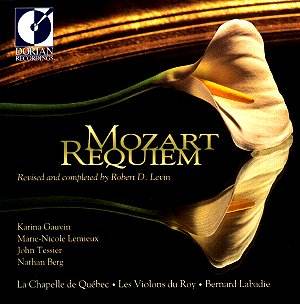When a great composer dies leaving a final work unfinished,
sometimes the work is completed by his students or friends and enters
the repertoire with barely a ripple of comment. Bartók’s Viola
Concerto, Borodin’s Prince Igor, Tchaikovsky’s Third Piano Concerto
and Prokofiev’s cello sonata are examples. Sometimes the work remains
uncompleted and the subject of years of discussion, even controversy,
before, eventually, someone is able to produce a satisfactory completion.
Bach’s Kunst der Fuge, Mahler’s Tenth Symphony, Berg’s Lulu,
and Elgar’s Third Symphony come to mind. In some cases the work is published
complete and only many years later are questions raised. In this latter
category lie Offenbach’s Les Contes d’Hoffmann and the Mozart
Requiem.
At the time of his death, Mozart had written out the
vocal parts and accompanying bass part of 10 of the work’s 14 sections
and the first 8 bars of the Lacrymosa. The familiar version of
this magnificent work was produced for Constanze Mozart by three of
Mozart’s students—Freystätdler, Eybler, and Süssmayer—and
delivered in satisfaction of the commission with a forged signature
on the colluded manuscript. Besides filling out the orchestration of
the entire work, Süssmayer is credited with composing anew the
Sanctus, Benedictus, Agnus Dei, Osanna and
Lux Æterna. It was actually 1823 before serious questions
were raised as to just how much Mozart may have had had to do with it.
The fundamental problem is that this is exceptional
music and Süssmayer was an uninspired and unskilled composer, so
how much of his contribution to this work is based on Mozart’s lost
sketches or verbal instructions? Levin argues that quite a bit of it
is authentic Mozart, clumsily worked out by Süssmayer. Levin carefully
works around the bits of what he sees as authentic Mozart and patches
up Süssmayer’s inept extensions. The result is certainly the finest
version of the work I’ve ever heard, and since it was premiered in a
1991 recording by Helmuth Rilling it has also been recorded by Martin
Pearlman and now Bernard Labadie.
Throughout, the orchestral accompaniment is lighter
and more supple, which allows a smaller chorus to be more forward. The
additional fugues composed by Levin are beautifully done, perhaps with
just the merest echo of the Mozart c-minor mass and the Bach b-minor
mass. The "repairs" of Süssmayer’s work are seamless
and have the effect of making the work feel more consistent and more
fluent. I have sung the Süssmayer version and expected to feel
the changes in my throat, but everything came off perfectly comfortably,
and my wonderful memories of working on this music are intact. The occasionally
recorded Maunder revision leaves out several major sections of the music,
but Levin includes all the familiar music and also composes an Amen
fugue (based on Mozart’s sketch) after the Lacrymosa so you get
your full money’s worth here. Levin’s revised Hosanna fugue is
in a single key and shortened in the reprise after the Benedictus
(in the customary style of 18th century church music),
and will be the other change noticeable to most listeners.
When I was in Montreal in 1997 I was privileged to
attend a marvellous performance of Rossini’s opera La Cenerentola
and my recollection is that many of these fine Canadian musical artists
were part of that performance, so I am not surprised at the excellence
of their work on this recording. Nor am I surprised that their approach
is operatic and dramatic. La Chapelle de Québec is a fully professional
choir and their precision and dramatic declamation in the denser choral
parts is truly thrilling. This is advertised as a live recording, but
there is no trace of audience sound except some discreet applause after
the end. Of the many performances of this work I’ve heard and cherished,
beginning with the Scherchen 1953 monophonic Ducretet-Thomson and including
the Harnoncourt, Hogwood, and Solti Vienna video versions, this recording
will now be my first choice.
However, with a work recorded as frequently as this,
a person can pick and choose until just the perfect version is discovered.
Some will prefer every note of the Süssmayer version out of familiarity,
and some will prefer a more solemn, weighty, reverent, even sentimental,
approach.
Paul Shoemaker
